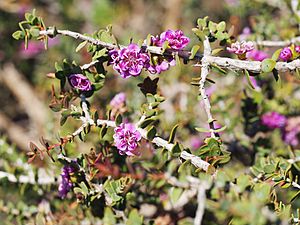Melaleuca violacea facts for kids
Quick facts for kids Melaleuca violacea |
|
|---|---|
 |
|
| M. violacea leaves and flowers | |
| Scientific classification | |
| Genus: |
Melaleuca
|
| Species: |
violacea
|
Melaleuca violacea is a special plant from the Myrtaceae family, which includes myrtles. You can only find it growing naturally in a small part of Western Australia, in the south-west. This plant is a small, bushy shrub that often grows low to the ground. It has pretty purple flowers and unique, star-shaped fruits.
Contents
What Melaleuca violacea Looks Like
Melaleuca violacea usually grows to be less than 1.5 m (5 ft) tall. It has many branches that spread out horizontally, making it look layered. Its leaves grow in pairs, one opposite the other. They are smooth, without any hairs. The leaves can be heart-shaped, oblong, or oval. They vary in size, usually 5–15 mm (0.2–0.6 in) long and 2–8 mm (0.08–0.3 in) wide. Each leaf has a short stalk.
The flowers are purple or violet and grow on older branches. They appear either alone or in groups of up to six. You can usually see them in spring, from July to November. Each flower has five bundles of stamens, which are the parts that hold pollen. Each bundle can have up to 25 stamens. The base of the flower is smooth and about 1.5–2 mm (0.06–0.08 in) long. After the flowers, the plant produces woody fruits called capsules. These fruits are about 2.5–3 mm (0.098–0.12 in) long and 4–6 mm (0.16–0.24 in) wide. When you look at the end of the fruit, the parts that used to be the sepals form a star shape.
Plant Names and History
This plant was first officially described in 1844 by a scientist named Johannes Conrad Schauer. He wrote about it in a book called Plantae Preissianae. The second part of its scientific name, violacea, comes from a Latin word. It means "violet-coloured," which describes the beautiful purple color of its flowers.
Where Melaleuca violacea Grows
You can find Melaleuca violacea growing in a wide area of Western Australia. It stretches from a town called Ravensthorpe all the way to Walpole. It also grows inland, near the Stirling Range and the Ongerup area. This plant likes to grow in sandy or clay soils. These soils are often found over limestone or laterite rock. You can spot it on low hills, wavy land, and even in swampy areas.
Protecting Melaleuca violacea
The Government of Western Australia's Department of Parks and Wildlife has looked at Melaleuca violacea. They have officially said that this plant is "not threatened." This means there are enough of these plants in the wild, and they are not currently in danger of disappearing.
Growing Melaleuca violacea in Gardens
There is a special type of this plant known as the "tabletop form." This form grows to about 50 cm (20 in) tall but can spread out to 1.5 m (60 in) wide. Gardeners often grow this specific type from cuttings. This helps them keep its special low-growing shape. It is a very tough plant and easy to grow. It does well in sunny spots or places with some shade. It can also grow in many different kinds of soil.
Images for kids
-
M. violacea growing at Cape Riche



